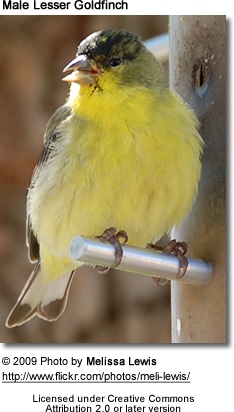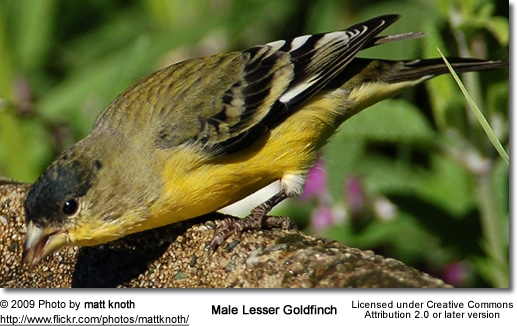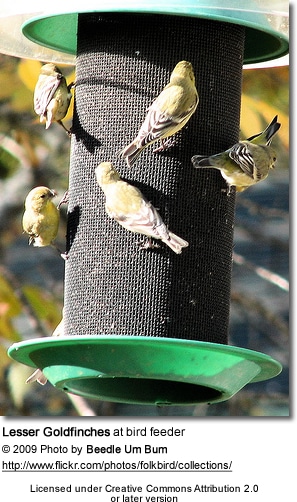Lesser Goldfinch (Carduelis psaltria)
The Lesser Goldfinches or Dark-backed Goldfinch (Carduelis psaltria) is a very small songbird found in the Americas. These sociable birds are usually found in flocks.
Range / Distribution:
The Lesser Goldfinches naturally occur in the southwestern United States (near the coast, as far north as extreme southwestern Washington) migrating south to winter in Venezuela and Peru in South America.
They inhabit areas with trees or shrubs except for dense forests.
They are common and conspicuous and often approach houses or visit gardens with bird feeders (thistle sock feeders in particular). Small groups of at least six of them are often found at the feeders.
Description:
The Lesser Goldfinch is the smallest North American Carduelis species. They average 10–11 cm (4–4.5 inches) in length and weigh about 9.5 g (0.3 oz).
Males have bright yellow under plumage and large white patches in the tail (outer tail feathers) and on the wings (the base of the primaries (longest wing feathers).
Males in most of the range have solid black upperparts, except for the males of the subspecies hesperophilus, in the far western U.S. and northwestern Mexico, which have olive-green napes and backs.
Both green-backed and black-backed (“Arkansas Goldfinch”, subspecies psaltria) males occur in Colorado and New Mexico, as do intergrade, and only black-backed males occur in southwestern Texas and most of Mexico.
Males of the subspecies colombianus, east and south of the Isthmus of Tehuantepec, are richer yellow below.

Females’ and immatures‘ upper plumages are more or less grayish olive-green; their underparts are yellowish, buffier in immatures. They have only a narrow strip of white on the wings (with other white markings in some forms) and little or no white on the tail.
They are best distinguished from other members of the genus by the combination of small size, upperparts without white or yellow, and dark gray bill.
Similar Species: In all plumages, this bird can easily be taken for a New World warbler if the typical finch bill isn’t seen well.
Vocalization / Calls:
Like other goldfinches, it has an undulating flight in which it frequently gives a call: in this case, a harsh chig chig chig [Sibley].
Another distinctive call is a very high-pitched, drawn-out whistle, often rising from one level pitch to another (teeeyeee) or falling (teeeyooo). The song is a prolonged warble or Twitter, more phrased than that of the American Goldfinch [Peterson], often incorporating imitations of other species.


Diet / Feeding:
The Dark-backed Goldfinch mostly feeds on tree buds and weed seeds.
They mostly feed on tree buds and weed seeds.
They feed on earthy or soil-like substances such as clay, and chalk, to obtain essential nutrients, such as sulfur and phosphorus from the soil.
Breeding / Nesting:
The Dark-backed Goldfinch female lays 3 to 4 bluish-white eggs.
The cup nest is made of fine plant materials such as lichens, rootlets, and strips of bark.
The nest is usually situated in a bush or at low or middle levels in a tree.
Please also refer to:



